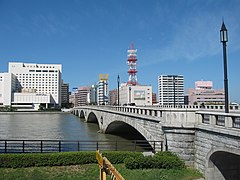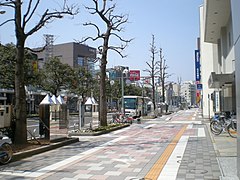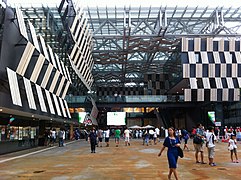Hokuriku region
This article needs additional citations for verification. (August 2011) |

The Hokuriku region (北陸地方, Hokuriku chihō) is located in the northwestern part of Honshu, the main island of Japan. It lies along the Sea of Japan and is part of the larger Chūbu region.[1] It is almost equivalent to the former Koshi Province and Hokurikudō area in pre-modern Japan.
From the Heian period until the Edo period, the region was a core recipient of population, and grew to be proportionately much larger than it is today, despite the rural character; in modern times, its population has remained consistent, with most urban growth in the 20th century instead taking place in Kanto, Chūkyō, and Kansai. The Hokuriku region is also known for traditional culture that originated from elsewhere that has been long lost along the Taiheiyō Belt.
The Hokuriku region includes the four prefectures of Ishikawa, Fukui, Niigata and Toyama,[2] although Niigata is sometimes included as an addition rather than being one of the core prefectures. It is similar to the following region definitions:
- Hokushin'etsu (北信越): includes both the Hokuriku and Shin'etsu regions
- Kōshin'etsu (甲信越): includes Niigata, Nagano and Yamanashi prefectures
- Shin'etsu (信越): includes Niigata and Nagano prefectures
Major cities
[edit]The major population centers of Hokuriku are:
Of these, Niigata is the largest with a population of over 800,000.
Industries
[edit]The main industries in the Hokuriku area include chemicals, medicine, tourism, textiles and textile machinery, heavy machinery, farming, and fishing. Koshihikari, a popular variety of rice is a special product of Hokuriku subregion.
Demographics
[edit]Per Japanese census data,[3][4] Hokuriku subregion has had negative population growth since year 2000.
| Year | Pop. | ±% |
|---|---|---|
| 1920 | 3,846,000 | — |
| 1930 | 4,087,000 | +6.3% |
| 1940 | 4,289,000 | +4.9% |
| 1950 | 5,179,000 | +20.8% |
| 1960 | 5,201,000 | +0.4% |
| 1970 | 5,137,000 | −1.2% |
| 1980 | 5,467,000 | +6.4% |
| 1990 | 5,584,000 | +2.1% |
| 2000 | 5,606,505 | +0.4% |
| 2010 | 5,443,799 | −2.9% |
| 2020 | 5,186,388 | −4.7% |
Climate
[edit]
The Hokuriku region has the highest volume of snowfall of any inhabited and arable region in the world. This is because dry Siberian air masses, which develop high humidity over the Sea of Japan, are forced upwards when they encounter the mountains of Honshū, causing the humidity to condense as snow.
The long winters and deep snow of this region are depicted in Hokuetsu Seppu, an encyclopedic work of the late Edo period which describes life in the Uonuma district of Niigata Prefecture.
The Hokuriku region is also the setting for Yasunari Kawabata's novel Snow Country.
Tourism
[edit]Hokuriku is listed as No. 4 in Lonely Planet's Best in Travel 2014 – Top 10 Regions.[5] The region has seen an influx of tourists since 2015 as the Hokuriku Shinkansen (formerly Nagano Shinkansen) extended its services from Nagano to Kanazawa, enabling direct bullet train services to the Hokuriku region from Tokyo. When services commenced in March 2015, the travel time from Tokyo to Toyama was reduced to about 2 hours, with Kanazawa an additional 30 minutes away.[6]
See also
[edit]- Hokuriku dialect
- Hokuriku Expressway
- Hokuriku Main Line
- Hokuriku Shinkansen
- Kitamaebune
- Kōshin'etsu region
- Shin'etsu region
- Tōhoku region
- Tōkai region
References
[edit]- ^ Nussbaum, Louis-Frédéric. (2005). "Chūbu" in Japan Encyclopedia, p. 126, p. 126, at Google Books.
- ^ Nussbaum, "Hokuriku" at p. 344, p. 344, at Google Books.
- ^ Niigata 1995-2020 population statistics
- ^ "Japan Prefectures Population from 1920 and Area". Demographia. Retrieved 2023-08-24.
- ^ Planet, Lonely. "Lonely Planet's Best in Travel 2014 - top 10 regions". Lonely Planet. Retrieved 2021-01-31.
- ^ "Hokuriku Shinkansen line between Nagano, Kanazawa completed - AJW by The Asahi Shimbun". 2014-05-28. Archived from the original on 2014-05-28. Retrieved 2021-01-31.
Citations
[edit]- Nussbaum, Louis-Frédéric and Käthe Roth (2005). Japan Encyclopedia. Cambridge, Massachusetts: Harvard University Press. OCLC 58053128. ISBN 0-674-01753-6, ISBN 978-0-674-01753-5.







